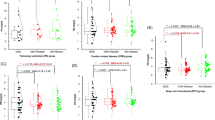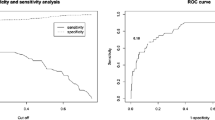Abstract
Purpose
The objectives of the study were to establish a dose–response model for warfarin based on the relationship between daily warfarin dose and international normalized ratio (INR) and to evaluate the stability and reliability of the established model using external data.
Methods
Clinical data were recorded from 676 outpatients with a steady-state warfarin dosage. Demographic characteristics, concomitant medications, daily dosage of warfarin, CYP2C9 and VKORC1 genotypes, and INR were recorded. Data analysis based on the Michaelis–Menten equation to describe the relationship between daily warfarin dose and INR was performed using NONMEM. The reliability and stability of the final model were evaluated using goodness-of-fit plots, resampling techniques with a nonparametric bootstrap, and external data.
Results
The daily warfarin dose and INR were described by a more pharmacologically expressive model than multivariate linear regression (MLR) model. The population standard value of Km was 3.56 mg, and the Hill coefficient was 0.512, with individual variabilities of 53.1% and 55.9%, respectively. CYP2C9 *1/*3, VKORC1 AA, concomitant amiodarone, and nonheart valve replacement reduced the warfarin Km by 30.4%, 74.3%, 34.5%, and 39.4%, respectively. The Km value decreased with age and increased with fat free mass (FFM). INR prediction error (73.0%) of the external datasets was within ± 20%.
Conclusion
A dose–response model of warfarin was established based on the relationship between daily warfarin dose and INR. Expected genotype effects on Km and demographic characteristics were confirmed. The model has the potential to be a powerful tool for individualized warfarin therapy for Chinese outpatients.



Similar content being viewed by others
References
International Warfarin Pharmacogenetics C, Klein TE, Altman RB, Eriksson N, Gage BF, Kimmel SE, Lee MT, Limdi NA, Page D, Roden DM, Wagner MJ, Caldwell MD, Johnson JA (2009) Estimation of the warfarin dose with clinical and pharmacogenetic data. N Engl J Med 360(8):753–764. https://doi.org/10.1056/NEJMoa0809329
Gong IY, Tirona RG, Schwarz UI, Crown N, Dresser GK, Larue S, Langlois N, Lazo-Langner A, Zou G, Roden DM, Stein CM, Rodger M, Carrier M, Forgie M, Wells PS, Kim RB (2011) Prospective evaluation of a pharmacogenetics-guided warfarin loading and maintenance dose regimen for initiation of therapy. Blood 118(11):3163–3171. https://doi.org/10.1182/blood-2011-03-345173
Limdi NA, Brown TM, Yan Q, Thigpen JL, Shendre A, Liu N, Hill CE, Arnett DK, Beasley TM (2015) Race influences warfarin dose changes associated with genetic factors. Blood 126(4):539–545. https://doi.org/10.1182/blood-2015-02-627042
O'Dell KM, Igawa D, Hsin J (2012) New Oral anticoagulants for atrial fibrillation: a review of clinical trials. Clin Ther 34(4):894–901. https://doi.org/10.1016/j.clinthera.2012.01.019
Wadhera RK, Russell CE, Piazza G (2014) Warfarin versus novel oral anticoagulants how to choose? Circulation 130(22):E191–E193. https://doi.org/10.1161/Circulationaha.114.010426
Bajalan M, Biggs TC, Jayaram S, Mainwaring J, Salib R (2015) A guide to new anticoagulant medications for ENT surgeons. J Laryngol Otol 129(12):1167–1173. https://doi.org/10.1017/S0022215115002765
Limdi NA, Veenstra DL (2008) Warfarin pharmacogenetics. Pharmacotherapy 28(9):1084–1097. https://doi.org/10.1592/phco.28.9.1084
Turagam MK, Velagapudi P, Bongu NR, Kocheril AG (2014) Novel anticoagulants vs warfarin for stroke prevention in atrial fibrillation. Cardiovasc Hematol Disord Drug Targets 14(1):79–86
Hirsh J, Fuster V, Ansell J, Halperin JL, American Heart A, American College of Cardiology F (2003) American Heart Association/American College of Cardiology Foundation guide to warfarin therapy. Circulation 107(12):1692–1711. https://doi.org/10.1161/01.CIR.0000063575.17904.4E
Hamberg AK, Dahl ML, Barban M, Scordo MG, Wadelius M, Pengo V, Padrini R, Jonsson EN (2007) A PK-PD model for predicting the impact of age, CYP2C9, and VKORC1 genotype on individualization of warfarin therapy. Clin Pharmacol Ther 81(4):529–538. https://doi.org/10.1038/sj.clpt.6100084
Xue L, Holford N, Ding XL, Shen ZY, Huang CR, Zhang H, Zhang JJ, Guo ZN, Xie C, Zhou L, Chen ZY, Liu LS, Miao LY (2017) Theory-based pharmacokinetics and pharmacodynamics of S- and R-warfarin and effects on international normalized ratio: influence of body size, composition and genotype in cardiac surgery patients. Br J Clin Pharmacol 83(4):823–835. https://doi.org/10.1111/bcp.13157
Zhao L, Chen CX, Li B, Dong L, Guo YQ, Xiao XJ, Zhang EY, Qin L (2014) Verification of pharmacogenetics-based warfarin dosing algorithms in Han-Chinese patients undertaking mechanic heart valve replacement. PLoS One 9 (4) DOI ARTN e94573 https://doi.org/10.1371/journal.pone.0094573
Wu LX, Qi L, Li Y (2016) Challenges faced by young Chinese doctors. Lancet 387 (10028): 1617–1617
Hamberg AK, Hellman J, Dahlberg J, Jonsson EN, Wadelius M (2015) A Bayesian decision support tool for efficient dose individualization of warfarin in adults and children. BMC Med Inform Decis Mak 15:7. https://doi.org/10.1186/s12911-014-0128-0
Janmahasatian S, Duffull SB, Ash S, Ward LC, Byrne NM, Green B (2005) Quantification of lean bodyweight. Clin Pharmacokinet 44(10):1051–1065. https://doi.org/10.2165/00003088-200544100-00004
Ding JJ, Wang Y, Lin WW, Wang CL, Zhao LM, Li XG, Zhao ZG, Miao LY, Jiao Z (2015) A population pharmacokinetic model of Valproic acid in pediatric patients with epilepsy: a non-linear pharmacokinetic model based on protein-binding saturation. Clin Pharmacokinet 54(3):305–317. https://doi.org/10.1007/s40262-014-0212-8
Sasaki T, Tabuchi H, Higuchi S, Ieiri I (2009) Warfarin-dosing algorithm based on a population pharmacokinetic/pharmacodynamic model combined with Bayesian forecasting. Pharmacogenomics 10(8):1257–1266. https://doi.org/10.2217/pgs.09.65
Ette EI, Williams PJ (2004) Population pharmacokinetics I: background, concepts, and models. Ann Pharmacother 38(10):1702–1706. https://doi.org/10.1345/aph.1D374
Minto C, Schnider T (1998) Expanding clinical applications of population pharmacodynamic modelling. Br J Clin Pharmacol 46(4):321–333. https://doi.org/10.1046/j.1365-2125.1998.00792.x
Yuan HY, Chen JJ, Lee MT, Wung JC, Chen YF, Charng MJ, Lu MJ, Hung CR, Wei CY, Chen CH, Wu JY, Chen YT (2005) A novel functional VKORC1 promoter polymorphism is associated with inter-individual and inter-ethnic differences in warfarin sensitivity. Hum Mol Genet 14(13):1745–1751. https://doi.org/10.1093/hmg/ddi180
Heimark LD, Wienkers L, Kunze K, Gibaldi M, Eddy AC, Trager WF, Oreilly RA, Goulart DA (1992) The mechanism of the interaction between amiodarone and warfarin in humans. Clin Pharmacol Ther 51(4):398–407
Acknowledgments
The authors would like to acknowledge the Chinese individualized drug therapy group of the International Network for the Rational Use of Drugs (INRUD). The authors would also like to acknowledge the English language editing of American Journal Experts.
Funding
This study was supported by the National Natural Science Foundation of China (grant numbers 81803628, 81700298, and 81503140), the National Key New Drug Creation Special Programs (2017ZX09304-021), the Suzhou Key Laboratory of Drug Clinical Research and Personalized Medicine (SZS201719), and People’s Livelihood Science and Technology Foundation of Suzhou Science and Technology Bureau (SYS201736).
Author information
Authors and Affiliations
Corresponding authors
Ethics declarations
The present study was approved by the Health Authority Ethics Committee of the First Affiliated Hospital of Soochow University and was in accordance with the Declaration of Helsinki.
Conflict of interest
The authors declare that they have no conflict of interest.
Additional information
Publisher’s note
Springer Nature remains neutral with regard to jurisdictional claims in published maps and institutional affiliations.
Ling Xue, Yuzhen Zhang, and Cheng Xie should be considered joint first author.
Electronic supplementary material
ESM 1
(DOCX 1275 kb)
Rights and permissions
About this article
Cite this article
Xue, L., Zhang, Y., Xie, C. et al. Relationship between warfarin dosage and international normalized ratio: a dose–response analysis and evaluation based on multicenter data. Eur J Clin Pharmacol 75, 785–794 (2019). https://doi.org/10.1007/s00228-019-02655-8
Received:
Accepted:
Published:
Issue Date:
DOI: https://doi.org/10.1007/s00228-019-02655-8




